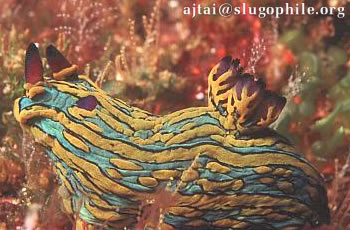
Tambja abdere
Farmer 1978
Order: NUDIBRANCHIA
Suborder: DORIDINA
Superfamily: ANADORIDOIDEA
Family: Polyceridae
Subfamily: Nembrothinae
DISTRIBUTION
Pacific coast of central America
PHOTO
Costa Rica. Photo: Peter Ajtai
Tambja abdere and Tambja fusca were described in the same paper (Farmer, 1978) but are now considered to be colour variants of a single species. The basic body coloration consists of turquoise blue-green and yellow-ochre regions, separated by black lines. In some specimens, such as in the accompanying photo, colour pattern is quite orderly with a turquoise background and longitudinal bands of yellow ochre, separated by thin black lines. In the T. fusca form the yellow ochre predominates and the turquoise consists of a series of irregular spots and patches. The gills and rhinophore clubs are a dark brownish black, and the outer edge of the gill rachis is yellow. There is a very distinctive translucent dark patch behind each rhinophore above where the eye is situated on the nerve ring. Animals grow to 80 mm in length, and are often found on their food - arborescent bryozoans. They are often eaten by Roboastra tigris.
-
Farmer, W.M. (1978) Tambja and Roboastra (Mollusca: Opisthobranchia) from the Gulf of California and the Galapagos Islands. The Veliger, 20(4): 375-385.
Rudman, W.B., 2002 (May 22) Tambja abdere Farmer 1978. [In] Sea Slug Forum. Australian Museum, Sydney. Available from http://www.seaslugforum.net/find/tambabde
Related messages
Tambja abdere from Bahia California [2]
May 17, 2007
From: Natasja Vandeperre

Although I found this animal not so far away from the one in my previous message [#19130] there's a big difference in coloration. At this reef Tambja abdere seemed to be very common.
Locality: La Paz, Mexico, Swanaa Reef, 9 m, Baia California, Sea of Cortez, 19 July 2006, Shallow Reef. Photographer: Natasja Vandeperre.
Natasja Vandeperre
nvandeperre@pandora.be
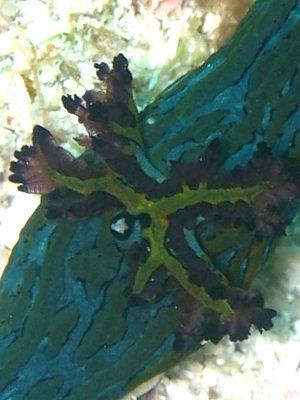
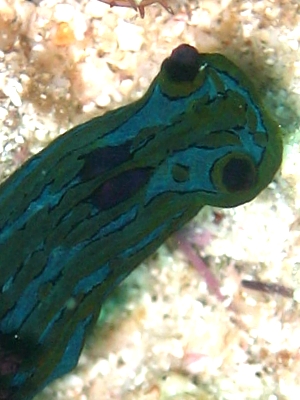
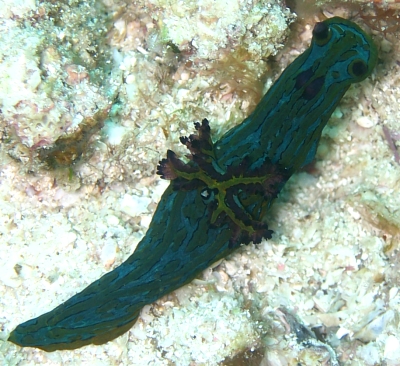
Thanks Natasja,
The main colour difference appeaes to be that in these animals the yellow seems to be in continuous lines rather than the broken lines of the animals in your earlier message.
Best wishes,
Bill Rudman
Tambja abdere from Bahia California
May 17, 2007
From: Natasja Vandeperre
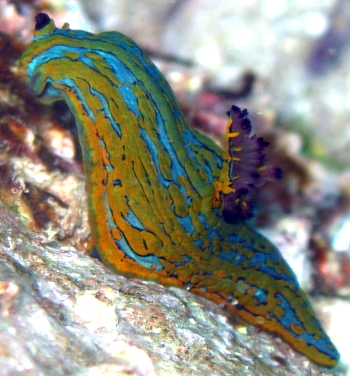
Dear Bill
Here are some photos of Tambja abdere from Mexico.
Locality: La Paz, Mexico, Swanaa Reef, 9 m, Baia California, Sea of Cortez, 10 July 2006, Shallow Reef. Photographer: Natasja Vandeperre.
Natasja Vandeperre
nvandeperre@pandora.be
Vandeperre, N., 2007 (May 17) Tambja abdere from Bahia California. [Message in] Sea Slug Forum. Australian Museum, Sydney. Available from http://www.seaslugforum.net/find/19130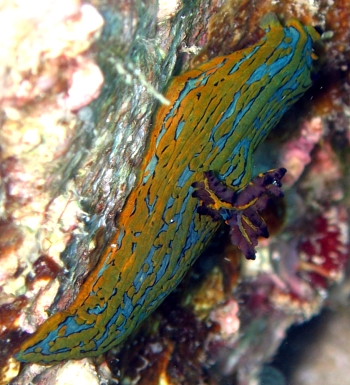
Thanks Natasja,
Best wishes,
Bill Rudman
Tambja abdere from the Sea of Cortez
September 23, 2003
From: Marli Wakeling
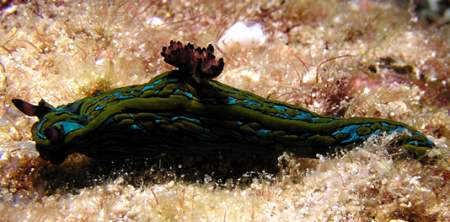
Hi Bill,
This is another record from the Sea of Cortez [Gulf of California]. Looks like a Tambja or Nembrotha. Would you be able to identify it?
Date: Sept. 2003
Photo: Rand McMein
Cheers,
Marli Wakeling
scubamarli@excite.com
Wakeling, M., 2003 (Sep 23) Tambja abdere from the Sea of Cortez. [Message in] Sea Slug Forum. Australian Museum, Sydney. Available from http://www.seaslugforum.net/find/10992Dear Marli,
I am pretty sure this is Tambja abdere. It looks a bit different from the photos we already have on the Forum but I think this is probbaly the colour form that was initially described as Tambja fusca, although the background colour in this specimen is more green than the 'yellowish ochre' mentioned in earlier descriptions. It also looks quite like Tambja eliora but in that species the gills and rhinophores are a dark bluish black with light blue lines while in this species they are translucent pinkish brown with black tips.
This is a nice colour variant to have on the Forum
Best wishes
Bill Rudman
Tambja abdere from Mexico
September 25, 2002
From: Carlos C. Ramos Mantecon
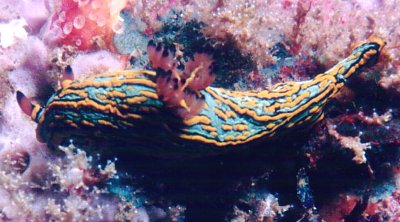

I've found your website very interesting and informative. I don't have experience or wide knowledge about slugs, but I have observed many different species right here, in Huatulco, State of Oaxaca, South Pacific of Mexico.
I'm sending you two pictures of a very common slug resident on this area. I've tried to find it on your website, but it looks almost impossible - there are hundreds of them!. These pictures were taken at 50 ft of water with a Nikonos IV-A, 35 mm lens and a tube extension. The bottom was rock, on November, 1998.
There is another species very similar in color , but it has a longitudinal mantles, making it to look like letuce leaves.
I would like to send my pictures. Probably they'll be of interest for the nudibranchs fans.
Saludos.
Carlos
charlie_diver@hotmail.com
Ramos Mantecon, C.C., 2002 (Sep 25) Tambja abdere from Mexico. [Message in] Sea Slug Forum. Australian Museum, Sydney. Available from http://www.seaslugforum.net/find/7951Dear Carlos,
Thanks for the photos. Your animal is Tambja abdere, which is only found on the Pacific coast of central America. It feeds on bryozoans, and in turn is hunted and eaten by another nudibranch, Roboastra tigris which is very similar in shape and colour. Have a look at the other messages on this page and the Roboastra tigris page for some background information. I look forward to any other 'sea slug' photos you are able to send.
Best wishes,
Bill Rudman
Juvenile and adult Tambja abdere
May 26, 2002
From: Peter Ajtai

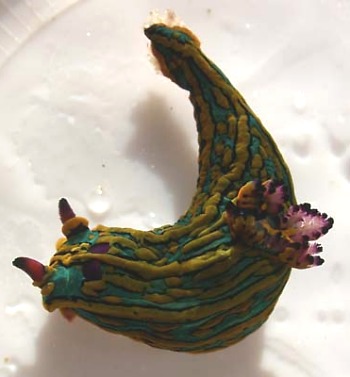
Dear Bill,
Here is a photo of a juvenile (I think, it was much smaller than the adults) Tambja abdere and an adult T. abdere. What are continuous straight lines of yellow in the juvenile, seem to break up into discontinuous lines in the adult.
Unfortunately, these aren't pictures of the same individual, so I don't know what the juvenile is going to grow up to look like...
The photos were taken by Ingo Wehrtmann.
The juvenile was found in tide pools at neap tide in Tamarindo, Costa Rica in March. The adult was found on April 25, off of Isla Pelada at 40ft, in the Islas Murcielago chain. Isla Pelada is composed mostly of serpentine rock.
Just thought the photos were interesting. Especially with the continuous blue line and blue spot variability in Tambja eliora.
Take care,
Peter Ajtai.
http://www.slugophile.org
ajtai@slugophile.org
Ajtai, P., 2002 (May 26) Juvenile and adult Tambja abdere. [Message in] Sea Slug Forum. Australian Museum, Sydney. Available from http://www.seaslugforum.net/find/7050Thanks Peter,
Photos showing colour variation are always of interest. The juvenile hasn't as yet developed any yellow on the outside edge of the gills.
Best wishes,
Bill Rudman
Tambja abdere - spots behind rhinophores
May 24, 2002
From: Peter Ajtai

Dear Bill,
I've been noticing that a lot of Tambja - well, at least the Tambja abdere and Tambja eliora I've seen - have a pair of two dark patches behind their rhinophores. Do you know what this is. Could it be the patch beneath which the eyes are located?
In the photo, you can see one of these spots just to the right of the rhinophore. All of these guys that I've seen seem to have it. Thanks for your help...
Cheers,
Peter Ajtai.
ajtai@slugophile.org
Ajtai, P., 2002 (May 24) Tambja abdere - spots behind rhinophores. [Message in] Sea Slug Forum. Australian Museum, Sydney. Available from http://www.seaslugforum.net/find/6908Dear Peter,
Yes the dark patch is associated with the postion of the eyes. The eyes are below the patch and the skin, sitting on the nerve ring around the oesophagus. Since the eyes can't form images, I guess it allows the eyes to sense light and dark, and shadows passing over the head. You can find similar 'patches' in many nudibranchs with opaque pigment on the dorsum. They are most noticeable in species in which the pigment is dark and very opaque. In species, such as these two species of Tambja with a dark brownish translucent colour to the skin, the patches are very obvious. Another species of Tambja with very obvious 'eye patches' is Tambja ceutae Garcia-Gomez & Ortea 1988.
Best wishes,
Bill Rudman
